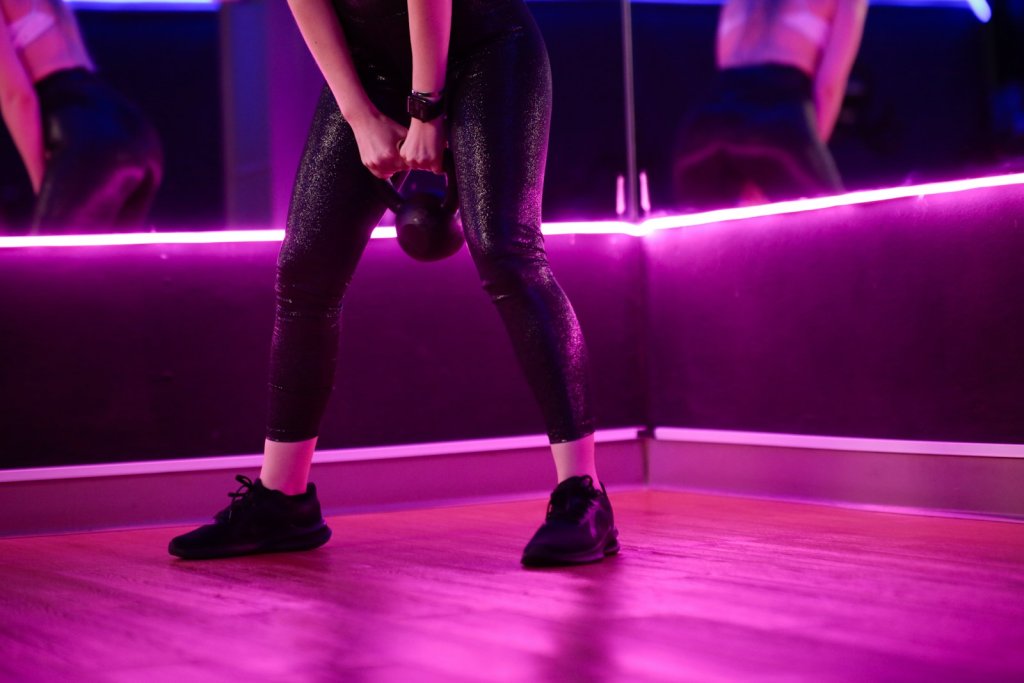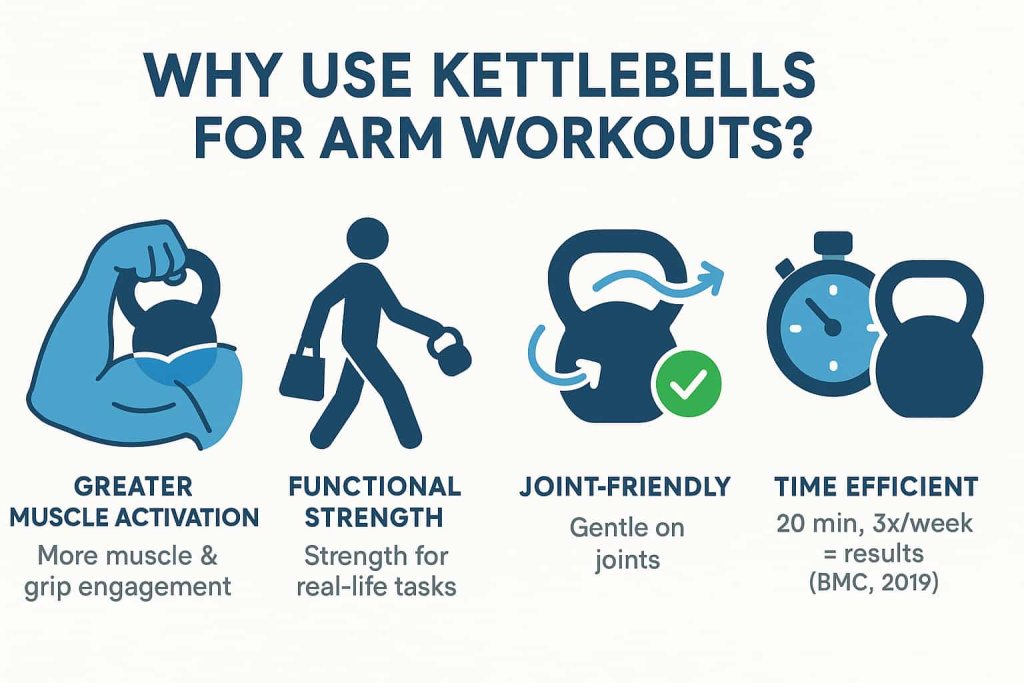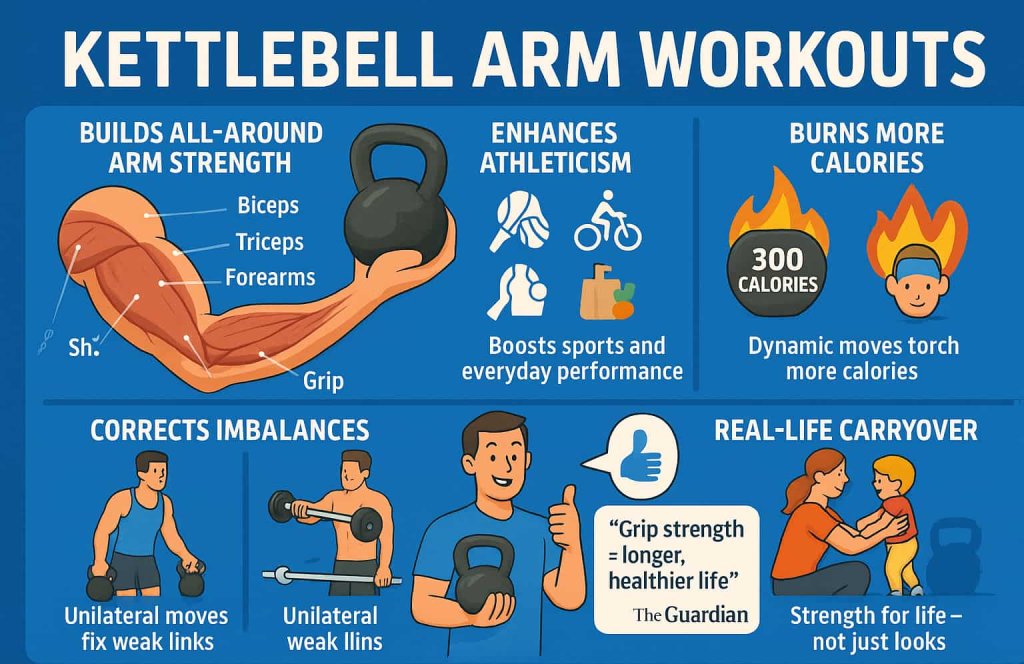The best kettlebell arm workouts don’t just build muscle—they deliver functional strength, better grip, joint protection, and athletic arms you can actually use. Kettlebells challenge your muscles with unique movement patterns and grip positions, engaging the biceps, triceps, forearms, and shoulders in ways that dumbbells simply can’t match.

If you’re looking to maximize your arm training at home or in the gym, kettlebell exercises offer a time-efficient, results-driven solution. Whether you’re a beginner or seasoned lifter, these 12 kettlebell arm moves—backed by research and trainer experience—can transform your arms, boost your confidence, and even improve overall health.
- Science shows kettlebell workouts increase strength, muscle tone, and grip power—even in older adults or those short on time (Business Insider, 2024, VeryWell Health, 2024).
- Certified trainers love kettlebell moves for arms because they activate stabilizers, correct muscle imbalances, and boost functional performance.
- All you need is a single kettlebell—no expensive machines or crowded gym needed!
Why Use Kettlebells for Arm Workouts?
The Science Behind Kettlebell Training

Kettlebells offer several advantages over traditional dumbbells and machines:
- Greater muscle activation: The offset center of mass and swinging motion of kettlebells force your muscles (especially in the arms and grip) to work harder to stabilize the weight. EMG studies confirm higher forearm and stabilizer engagement compared to standard weights.
- Functional strength: Movements with kettlebells often mimic real-life tasks (carrying, lifting, swinging), helping translate gym gains into everyday performance—whether that’s carrying groceries or improving your tennis game.
- Joint-friendly: Kettlebell exercises are typically more fluid and natural, reducing strain on elbows and wrists. This makes them ideal for people with joint sensitivities or those seeking longevity in their fitness routine.
- Time efficiency: Research published in BMC Sports Science, Medicine and Rehabilitation found that as little as 20 minutes of kettlebell training 3 times per week leads to measurable increases in strength, muscle size, and cardiovascular health—even in adults over 60 (BMC, 2019).
Real-World Example: Peloton and NASM-certified trainers regularly incorporate kettlebell arm exercises for clients who want sculpted, strong arms without bulking up too much. Even older adults and beginners see improvements in grip and muscle tone after just a few weeks (Tom’s Guide, 2024).
How Kettlebell Arm Workouts Boost Your Results

Benefits at a Glance
- Builds all-around arm strength: Biceps, triceps, forearms, shoulders, and grip
- Enhances athleticism: Improves performance in sports and daily activities
- Corrects imbalances: Unilateral (one-sided) exercises force each arm to pull its weight, addressing weaknesses
- Burns more calories: Full-body tension and dynamic moves = more energy expenditure per session
Why Trainers Recommend Kettlebell Arm Workouts
- Grip strength is foundational: Research shows grip strength is directly linked to longevity, heart health, and even cognitive performance (The Guardian, 2024).
- Unmatched versatility: With just one kettlebell, you can work every arm muscle through curls, presses, carries, and dynamic swings.
- Real-life carryover: From lifting kids to carrying suitcases, kettlebell training prepares your arms for real challenges—not just mirror selfies.
The 12 Best Kettlebell Arm Exercises (With Detailed Guide)
1. Kettlebell Biceps Curl
How to do it: Hold the kettlebell by the handle (palms facing up) with one or both hands. Keep elbows tight to your sides, curl the weight up, and lower slowly with control.
Pro Tips: Focus on squeezing your biceps at the top. Don’t let your elbows drift forward or outward.
Trainer Insight: Slower negatives (3-4 seconds on the way down) dramatically boost muscle growth (hypertrophy).
2. Kettlebell Hammer Curl
How to do it: Grip the kettlebell by the handle, palm facing your torso. Curl the bell up, keeping the wrist neutral and thumb pointed up.
Benefits: Hits the brachialis and brachioradialis, the key muscles for “thick” arms and strong grip.
Tip: Try alternating arms for better isolation and core stability.
3. Kettlebell Overhead Triceps Extension
How to do it: Lift the kettlebell overhead with both hands, lower it behind your head (keeping elbows close to your ears), then extend arms fully upward.
Key Points: Engage your core to avoid arching your back. Use lighter weights at first to master technique.
Real-World Application: This move mimics reaching overhead to lift objects, so it’s great for both athletes and parents!
4. Kettlebell Skull Crusher (Lying Triceps Extension)
How to do it: Lie on your back, hold a kettlebell in both hands above your chest, and bend elbows to lower it toward your forehead. Press back up.
Benefits: Directly isolates the triceps—essential for building the back of your arms.
Pro Tip: Keep upper arms still; only your forearms should move.
5. Kettlebell Floor Press
How to do it: Lie on your back with a kettlebell in each hand, elbows on the ground. Press the weights up, squeezing your triceps at the top.
Advantages: Less shoulder strain than bench presses; perfect for home training or those with sensitive shoulders.
Expert Insight: Emphasize a strong lockout at the top for better triceps activation.
6. Kettlebell Single-Arm Row
How to do it: Place one hand and knee on a bench, holding the kettlebell in the opposite hand. Row the weight up to your hip, keeping elbow close.
Muscles Worked: Biceps, forearms, rear delts, lats, and even core stabilizers.
Pro Tip: Don’t rotate your torso—keep your chest facing the ground.
7. Kettlebell Clean
How to do it: Start with the kettlebell between your feet, swing it up and “catch” it in a racked position at your shoulder.
Why It’s Great for Arms: The explosive pulling phase torches the biceps and forearms, while the catch demands shoulder stability.
Real-World Example: This move is the foundation for kettlebell snatches and presses, used by CrossFit athletes and powerlifters alike.
8. Kettlebell High Pull
How to do it: Swing the kettlebell up to chest height, leading with your elbow high and out to the side.
Muscles Targeted: Biceps, rear delts, upper traps, and forearms.
Trainer Tip: Keep the kettlebell close to your body for safety and maximum muscle engagement.
9. Kettlebell Bottoms-Up Press
How to do it: Hold the kettlebell upside-down (bottom up) at shoulder height and press overhead.
Unique Challenge: This move intensely activates grip, forearms, shoulders, and stabilizer muscles due to the instability of the bell.
Pro Tip: Start light—this is harder than it looks!
10. Kettlebell Crush Grip Curl
How to do it: Hold the kettlebell by the round part (not the handle), squeeze hard, and curl up.
Benefit: Develops crushing grip and biceps together; trains forearm endurance.
Expert Advice: Add slow pauses at the top for maximum muscle tension.
11. Kettlebell Triceps Kickback
How to do it: With one knee on a bench, hinge forward, keep upper arm parallel to your body, and kick the kettlebell back to straighten the elbow.
Muscles Worked: Triceps, with added grip and shoulder stability.
Practical Tip: Use a light kettlebell to maintain form and full range of motion.
12. Kettlebell Farmer’s Carry
How to do it: Hold heavy kettlebells at your sides, keep shoulders back, and walk for time or distance.
Full-Body Benefits: Builds massive grip, biceps, forearms, traps, and even core strength. Excellent for posture and functional strength.
Trainer Recommendation: Go for 30–60 seconds per set or as far as possible with good form.
Sample Kettlebell Arm Workout Routine
Here’s a science-backed kettlebell arm session you can do 2–3 times per week:
- Warm-up: Arm circles, shoulder rolls, and 1–2 sets of light kettlebell halos
- Workout:
- Kettlebell Biceps Curl – 3 sets x 10–12 reps
- Kettlebell Overhead Triceps Extension – 3 sets x 10–12 reps
- Kettlebell Hammer Curl – 2 sets x 12 reps
- Kettlebell Floor Press – 3 sets x 8–10 reps
- Kettlebell Bottoms-Up Press – 2 sets x 8 reps (each arm)
- Kettlebell Farmer’s Carry – 2–3 sets x 40–60 seconds
- Cool-down: Forearm and triceps stretches
Common Mistakes (and How to Fix Them)
- Using too much weight: Always master technique before increasing load.
- Rushing through reps: Slow, controlled movements yield better results.
- Neglecting grip strength: Choose exercises that challenge your grip regularly.
- Ignoring pain signals: Kettlebell training should challenge, not hurt your joints. Adjust as needed.
Frequently Asked Questions (FAQs)
Q: Are kettlebell arm workouts suitable for beginners?
A: Absolutely! Start with light weights, focus on technique, and progress as you get stronger. Many kettlebell exercises can be scaled for any fitness level.
Q: Can I build big arms with kettlebells alone?
A: Yes—kettlebells can build significant muscle and strength in your arms, especially if you use progressive overload and eat enough protein.
Q: How do kettlebells compare to dumbbells for arm gains?
A: Kettlebells require more stabilizer and grip activation, offering different (sometimes better) benefits for functional strength, joint health, and endurance. Combining both tools is ideal for maximum results.
Q: How often should I train arms with kettlebells?
A: For most people, 2–3 focused sessions per week, with 1–2 days of rest between, is ideal for muscle growth and recovery.
Q: Can women and older adults use these exercises?
A: Yes! Research shows kettlebell training is safe and effective for all ages and genders—just start with a weight you can control (VeryWell Health, 2024).
Q: What’s the best kettlebell weight for arm workouts?
A: Beginners often start with 8–12 kg (18–26 lbs). Adjust as needed for your fitness level and the specific exercise.
Conclusion
Ready to sculpt powerful, functional arms and bulletproof your grip strength? Add these 12 kettlebell arm exercises to your routine and watch your results accelerate. Remember: start light, master your form, and gradually progress in weight and reps.
